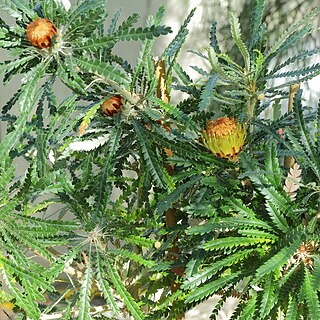Related Research Articles

Banksia formosa, commonly known as showy dryandra, is a species of shrub that is endemic to the south-west of Western Australia. It has pinnatipartite leaves with up to forty triangular lobes on each side, up to more than two hundred, conspicuous golden orange flowers and up to sixteen egg-shaped follicles in each head.

Lambertia formosa, commonly known as mountain devil, is a shrub of the family Proteaceae, endemic to New South Wales, Australia. First described in 1798 by English botanist James Edward Smith, it is the type species of the small genus Lambertia. It is generally found in heathland or open forest, growing in sandstone-based soils. It grows as a multistemmed shrub to around 2 m (7 ft) with a woody base known as a lignotuber, from which it regrows after bushfire. It has stiff narrow leaves, and the pink to red flowerheads, made up of seven individual tubular flowers, generally appear in spring and summer. It gains its common name from the horned woody follicles, which were used to make small devil-figures.

Formosa (1865–1881) was a British Thoroughbred racehorse that was the first winner of the English Fillies Triple Crown in addition to running a dead heat with the colt Moslem for the 2,000 Guineas Stakes. Formosa was bred by James Cookson and was foaled in 1865 at his Neasham Hall stud farm. Formosa was sold to William Graham in 1866 and raced her entire three-year racing career under his ownership. After her racing career ended in 1871, she became a broodmare for Graham until his death in 1876. Formosa was exported to France in 1879 and died there in February 1881. While she did not produce offspring that excelled at racing, her daughters that were exported to Germany and New Zealand did produce descendants that were successful racers.
Tragocephalini is a tribe of longhorn beetles of the subfamily Lamiinae. It was described by James Thomson in 1857.

Chariesthes is a genus of longhorn beetles of the subfamily Lamiinae, containing the following species:

Chariesthes bella is a species of longhorn beetles of the subfamily Lamiinae. It is found in Africa.
Chariesthes rutila is a species of beetle in the family Cerambycidae. It was described by Karl Jordan in 1894. It is known from Gabon and Equatorial Guinea.
Chariesthes donovani is a species of beetle in the family Cerambycidae. It was described by Karl Jordan in 1903, originally under the genus Hapheniastus. It is known from Sierra Leone, Cameroon, Ivory Coast, Gabon, Benin, Ghana, and Togo. It measures approximately 10 mm (0.39 in).
Chariesthes grisescens is a species of beetle in the family Cerambycidae. It was described by Stephan von Breuning in 1981, originally under the genus Pseudochariesthes. It is known from Kenya.
Chariesthes leonensis is a species of beetle in the family Cerambycidae. It was described by Stephan von Breuning in 1939. It is known from Liberia, Senegal, the Ivory Coast, Guinea, and Sierra Leone.
Chariesthes nigronotata is a species of beetle in the family Cerambycidae. It was described by Stephan von Breuning in 1956. It is known from South Africa.
Chariesthes subtricolor is a species of beetle in the family Cerambycidae. It was described by Stephan von Breuning in 1967. It is known from Gabon and Cameroon.
Chariesthes obliquevittata is a species of beetle in the family Cerambycidae. It was described by Stephan von Breuning in 1960. It is known from Tanzania.
Chariesthes nigroapicipennis is a species of beetle in the family Cerambycidae. It was described by Stephan von Breuning in 1977. It is known from Cameroon.
Chariesthes amoena is a species of beetle in the family Cerambycidae. It was described by Dalman in 1817, originally under the genus Lamia. It is known from the Central African Republic, Gabon, the Democratic Republic of the Congo, Cameroon, Nigeria, the Ivory Coast, and Sierra Leone.
Chariesthes fairmairei is a species of beetle in the family Cerambycidae. It was described by Per Olof Christopher Aurivillius in 1922, originally under the genus Hapheniastus. It is known from the Central African Republic and Gabon.
Chariesthes rubida is a species of beetle in the family Cerambycidae. It was described by Chevrolat in 1855, originally under the genus Mesosa. It is known from the Democratic Republic of the Congo, the Central African Republic, Cameroon, Equatorial Guinea, Nigeria, and Gabon. It contains the varietas Chariesthes rubida var. femoralis.
Chariesthes apicalis is a species of beetle in the family Cerambycidae. It was described by Péringuey in 1885, originally under the genus Tragiscoschema. It has a wide distribution in Africa.
Chariesthes obscura is a species of beetle in the family Cerambycidae. It was described by Charles Joseph Gahan in 1890, originally under the genus Phymasterna. It has a wide distribution in Africa.
Chariesthes rubra is a species of beetle in the family Cerambycidae. It was described by Hintz in 1912, originally under the genus Apheniastus. It is known from Cameroon and the Central African Republic.
References
- ↑ BioLib.cz - Chariesthes formosa. Retrieved 8 September 2014.